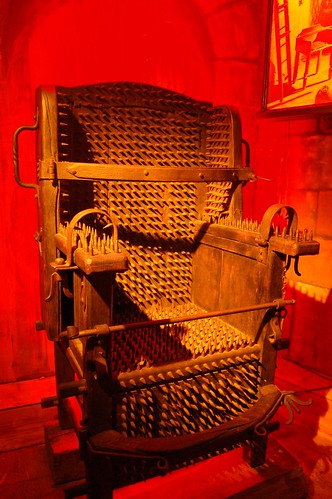
In 1326 Pope John XXII responded to Dominican pressure by making witchcraft an official heresy.
Until recently it’s been said that in 1486, two educated Dominicans monks, Heinrich Kramer and James Sprengler wrote the Malleus Maleficarum (The Hammer of Witches or Witches Hammer). However, some researchers believe that the book was written by Kramer, and Sprengler was merely added as an author to increase its supposedly authoritative status.
The book, based on Exodus 22:18 (“thou shalt not suffer a witch to live”), not only refuted the idea that witches are not real. It’s also is a grisly, perverse three-part manual on how to identify and legally force confessions out of suspected witches, who for all intents and purposes were considered guilty before their arrest.
Torture is outlined as an acceptable method for obtaining confessions.
Part I describes how the devil, with the permission of God, tempts people through various succubi and incubi, and turns them into animals.

Part II outlines how witches cast spells and bewitch people. This includes stories of pacts with the devil, the sacrifice of children and sexual intercourse with Satan. These stories were based on real inquisitions conducted by Kramer and Sprengler. And in retrospect, one wonders if they are not a map (i.e. projection) of the inquisitors’ own dark unconsciousness and hidden fantasies.
Part III provides methods for gathering evidence and testimony as well as outlining interrogation and torture techniques.
Judges were permitted to lie. They often said that mercy would be granted with a confession when in reality mercy was never on the agenda, confession or no confession. This kind of twisted lying apparently was for the “greater good.”
The book was also contradictory, at one point saying that many good people are susceptible to Demonic influence and, later, that only wicked individuals are vulnerable.
Although the Catholic Church officially banned The Witches Hammer in 1490, it was repeatedly published well into 1669. During that time many Inquisitors and witch-hunters used it as a how-to manual. And next to the Bible, it remained the No. 2 best-seller for almost 200 years after its first publication in 1486.

Meanwhile, the Church turned a blind eye to its popularity and widespread use, making the ban more an ethical and, perhaps, politically correct move than an actual measure.
Related Posts » Scholarship, Barbara G. Walker, Witch
On the Web:
- http://www.malleusmaleficarum.org
- http://jp2m.blogspot.com/2006/11/john-paul-ii-revived-inquisition.html (Contains potentially disturbing content not suitable for minors)
Related articles












Interesting and points to a sad historical point of the church. it shows how insanity when given religious blessing can truly result in evil. How many poor people were executed under such a heinuous edict?
LikeLike
That’s an interesting perspective. I probably would have framed it in terms of evil given religious blessing resulting in insanity! The numbers are higher than you would think. It was a real wave of twisted hysteria.
Some also think that material concerns were involved–i.e. lands of convicted ‘witches’ and even inheritance rights could be seized. A truly grisly epoch.
LikeLike
It also had a lot to do with sexual repression and perversion, which is why many of the “examinations” the “witches” were subjected to including stripping them naked, particularly the attractive young women, and poking and prodding all over their bodies. Many of the accusations centered on sexual themes: with the devil, succubi, incubi, orgies, etc. It was quite a money-mill as well. Incarcerated people had to pay for their own imprisonment. The new male medical establishment was particularly threatened by wise women healers. Consequently these women were often the targets of witchcraft accusations. We still see this today in third world countries where the village healer is suddenly accused of witchcraft and murdered for one reason or another. It’s one way to get rid of someone you don’t like.
LikeLike
Interesting and insightful comment!
LikeLike
Isn’t it interesting that there were more people killed in the name of religion throughout history than any other reason. Even today. Makes you think about believing in something else.
LikeLike
Or perhaps simply being critical about the cultural aspects of religion… from my perspective, there’s no need to throw the baby out with the bathwater…
LikeLike
that is almost right but the prisoners where raped
LikeLike
Thank you for your comment. I just added a second external link, prompted by your input.
LikeLike